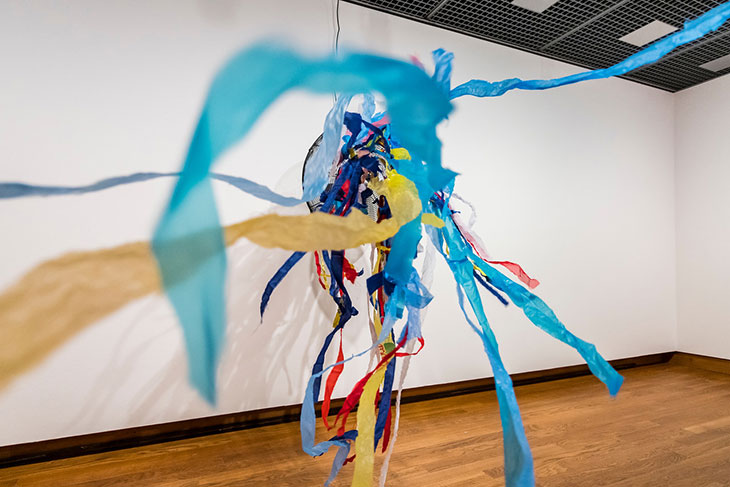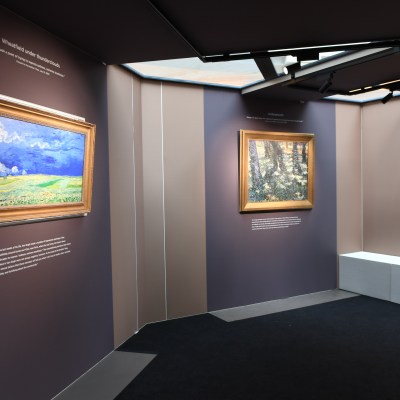In December 1887, Vincent and Theo Van Gogh made their most expensive acquisition as art collectors: they splashed out 400 francs on Paul Gauguin’s The Mango Trees, Martinique (1887). The investment was an unprecedented act of faith in a painter previously regarded as a marginal Impressionist, reaffirmed when Vincent traded two of his sunflower paintings for a second landscape, On the Banks of the River, Martinique (1887). For Gauguin this was a career-defining moment, justifying his decision earlier that year to take off for the tropics with his friend from Pont-Aven, Charles Laval, ‘to live like a native’.
Those two paintings and one pastel drawing by Gauguin, along with two watercolours and Landscape on Martinique (1887–88) by Laval, form part of the founding collection of the Van Gogh Museum – originally owned by the Van Gogh family and donated by Theo’s son to the Vincent van Gogh Foundation in 1962, 11 years before the opening of the museum. They have also inspired the museum’s latest exhibition, the first to focus on this neglected period in Gauguin’s career with a display of 81 paintings, drawings, prints and sculptures by the two artists.
Landscape on Martinique (1887–88), Charles Laval. Van Gogh Museum, Amsterdam (Vincent van Gogh Foundation)

Brought up by French parents in Peru, Gauguin liked to depict himself as an exotic outsider, in his more fanciful moments claiming descent from the Incas. In 1886, having failed impress at the eighth Impressionist exhibition where Georges Seurat and the Neo-Impressionists stole the show, he had left for Brittany in search of subject matter that would suit his self-identity and mark him out from the crowd. But Brittany wasn’t sufficiently exotic, and the following April he embarked with Laval for the Caribbean, taking up residence on Martinique in an empty plantation worker’s hut two kilometres from the then capital of Saint-Pierre.
For a post-colonial audience the spectacle of two European painters seeking an unspoiled paradise on a French colony covered in plantations is problematic, and as a corrective the curators have commissioned an installation by contemporary Martinican artist Jean-Francois Boclé presenting an alternative view. For the rest, we can at least be thankful that on this first trip to the tropics Gauguin has escaped accusations of sexual exploitation – which is not the case with his later trips to Tahiti – though he did confess in a letter to his wife Mette: ‘I assure you that a white man has difficulties keeping his robe on, because Potiphar ladies are not lacking here.’
Sans titre, série Caribbean Hurricane (2018), Jean-François Boclé. Photo: Jan-Kees Steenman. Courtesy Maëlle Gallery

The Potiphar ladies were the local porteuses who carried baskets of fruit and vegetables on their heads to market in Saint-Pierre, hard-working women pictured by Gauguin as native Pomonas. As well as promoting the myth of a bounteous Eden, the brightly dressed porteuses – and the occasional goat – serve a pictorial function in drawing the eye across wooded landscapes with no vanishing points, providing relief from all that tropical greenery.
To animate these masses of vegetation Gauguin developed a diagonal hatching technique compared by one French contemporary critic to a rainstorm, which together with his flattened perspectives created a decorative tapestry-like effect. But it was the lesser-known Laval, surprisingly, who produced the most abstract landscape in the exhibition. Among his six oil paintings and five watercolours and gouaches on display, Laval’s Landscape on Martinique (1887–88) stands out as startlingly radical. A patterned plane of wooded hills and valleys crossed by paths rising to mountain peaks wreathed in scroll-like clouds, it anticipates Maurice Denis’s definition of a picture as a ‘flat surface covered with colours arranged in a certain order’.
The Mango Trees, Martinique (1887), Paul Gauguin. Van Gogh Museum, Amsterdam (Vincent van Gogh Foundation)

Laval stayed on the island longer than Gauguin, who returned to France after four months to seek treatment for malaria, and this landscape may have been painted after his friend’s departure. In a letter of 9 December 1887 Laval acknowledged his debt to Gauguin as the ‘courageous older brother’ who ‘made me understand the superior strength that permits me to grow’. Further evidence of that newfound strength is provided in two animated watercolours of porteuses and a third of Two Riders on the Beach (1888), a dramatic image which he probably gave to Gauguin after his return to Pont-Aven in 1888.
Self-Portrait with Portrait of Émile Bernard (Les misérables) (1888), Paul Gauguin. Van Gogh Museum, Amsterdam (Vincent van Gogh Foundation)

But it was Gauguin who reaped the glory the following year in an exhibition at the Café des Arts coinciding with the world’s fair in Paris in 1889, where the pair first unveiled their works inspired by Martinique, despite exhibiting one Martinican landscape to Laval’s 10. What Gauguin successfully sold the French public was the image of himself as noble savage, reinforced after his return to France in a series of self-consciously primitive, pre-Columbian-inspired ceramics and carvings, of which a spirited selection is on show. As he told the writer Charles Morice in 1890, the year before he left for Tahiti: ‘I had a decisive experience in Martinique. It was only there that I felt like my real self, and one must look for me in the works I brought back from there rather than those from Brittany, if one wants to know who I am.’
‘Gauguin and Laval in Martinique’ is at the Van Gogh Museum, Amsterdam, until 13 January 2019.



